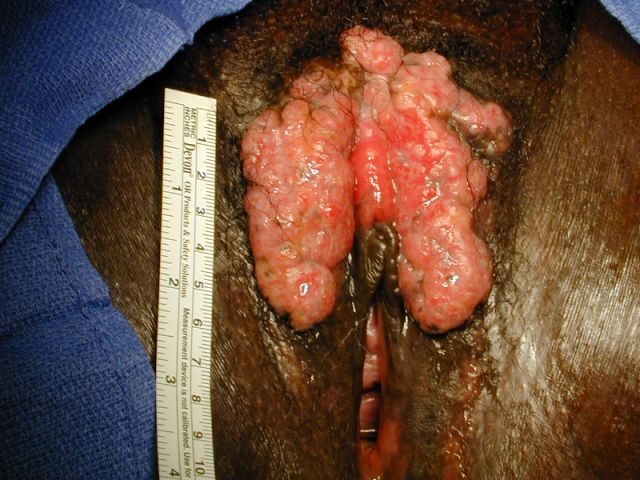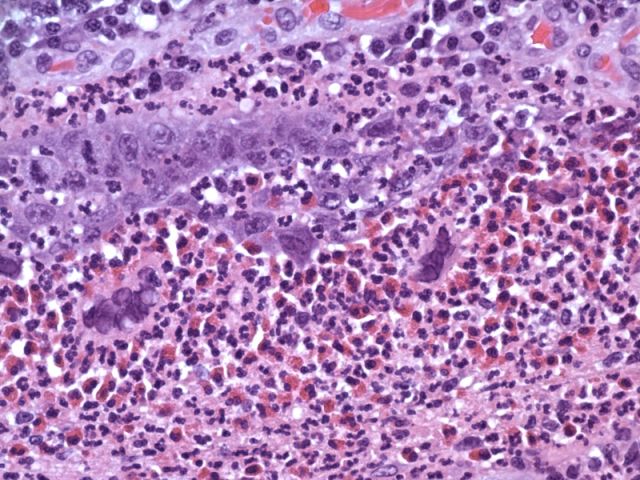Table of Contents
Candida | Gardnerella vaginalis (bacterial vaginosis) | Granuloma inguinale | Herpes simplex virus | Human papillomavirus (HPV) | Lymphogranuloma venereum | Molluscum contagiosum | Mycoplasma | Neisseria gonorrhea | Pelvic inflammatory disease | Syphilis | Trichomonas vaginalisCite this page: Roychowdhury M. Infection. PathologyOutlines.com website. https://www.pathologyoutlines.com/topic/vulvainfections.html. Accessed April 1st, 2025.
Candida
Definition / general
Etiology
Clinical features
Diagnosis
Treatment
- Causes vulvovaginitis; most frequent mycoses of women; 10% of women are carriers
- Risk factors: diabetes, oral contraceptives, pregnancy
- Transmission: male genitalia are not a relevant reservoir for recurrent vulvovaginal candidosis, thus decreasing the possibility of sexual heterosexual transmission (J Eur Acad Dermatol Venereol 2011;25:145)
- Recurrent vulvovaginal candidosis: mostly caused by identical Candida strains suggesting C. albicans persistence in female anogenital area, particularly in external vulva (Mycoses 2011;54:e807)
Etiology
- Acute vulvovaginitis: most commonly C. albicans, followed by C. glabrata
- Chronic recurrent vulvovaginitis: C. albicans and C. glabrata are often equally distributed (Med Monatsschr Pharm 2010;33:324)
Clinical features
- Small white surface patches with leukorrhea and itching
Diagnosis
- Fungal hyphae on wet mount
Treatment
- Local and systemic antimycotic agents based on the severity of disease and etiological agent
Gardnerella vaginalis (bacterial vaginosis)
Definition / general
- Small gram negative rods, implicated in vaginitis when other causes can't be found
- Presence of 3 of 4 criteria indicate BV (bacterial vaginosis, Medscape Womens Health 1997;2:2):
- Homogenous noninflammatory discharge (not many WBCs)
- pH > 4.5
- Clue cells (bacteria attached to border of epithelial cells, > 20% of epithelial cells)
- Positive "whiff" test
Granuloma inguinale
Definition / general
Clinical features
Microscopic (histologic) description
Differential diagnosis
- Caused by Calymmatobacterium granulomatis, an encapsulated, nonmotile gram negative rod
- Soft granulomatous area enlarges by peripheral extension and ulcerates
Clinical features
- Genital ulceration, genital tract bleeding
Microscopic (histologic) description
- Donovan bodies (small round encapsulated bodies within histiocytes), seen best with silver or Giemsa stains
- Also pseudoepitheliomatous hyperplasia, plasma cells, histiocytes, small abscesses
Differential diagnosis
- Soft tissue neoplasm if it spreads to retroperitoneum
- Squamous cell carcinoma
Herpes simplex virus
Definition / general
Clinical features
Case reports
Clinical images
Case #53
Images hosted on other servers:
Microscopic (histologic) description
Microscopic (histologic) images
Case #53
Images hosted on other servers:
- Sexually transmitted disease characterized by labial ulcers with punched out centers
- Usually HSV2 in young women
- 1/3 are symptomatic (lesions 3 - 7 days after sex); lesions heal in 1 - 3 weeks but virus is latent in regional nerve ganglia
- 2/3 suffer recurrences (less painful)
- High risk of transmission to neonate during vaginal birth, especially if active primary infection
- Rarely, in HIV positive patients, presents as chronic hyperproliferative plaque or mass in vulva or perianal region that clinically resembles malignancy (J Drugs Dermatol 2003;2:198)
Clinical features
- Extremely painful ("heartbreak of herpes"), papules in vulva, progress to vesicles, later coalescent ulcers
- Also affects vagina and cervix
Case reports
- 23 year old woman with associated necrotizing lymphadenitis (Arch Pathol Lab Med 1985;109:1043)
- 38 year old HIV+ woman with chronic herpes infection (Case Rep Dermatol 2012;4:192)
- 44 year old HIV+ woman with hypertrophic herpes simplex genitalis with concomitant early invasive squamous cell carcinoma (Int J Gynecol Pathol 2012;31:286)
- Patient with large fungated vulvar mass (Case of the Week #53)
Clinical images
Case #53
Images hosted on other servers:
Microscopic (histologic) description
- Multinucleated giant cells with molding, ground glass nuclei
- Hypertrophic masses show epithelial hyperplasia, brisk infiltrate of lymphocytes and plasma cells (Dis Colon Rectum 2005;48:2289)
Microscopic (histologic) images
Case #53
Images hosted on other servers:
Human papillomavirus (HPV)
Definition / general
Microscopic (histologic) images
Images hosted on other servers:
- HPV subtypes 6, 8,11,13 associated with papillary lesions
- HPV subtypes 16, 18, 31, 33 associated with flat lesions
- HPV 16 produces E6 protein that binds to p53 and E7 protein that binds to Rb protein
- Koilocytotic atypia is a viral cytopathic effect, often NOT present in vulvar condylomas
- Verrucopapillary lesions, even in children / young adults, are likely to be HPV associated (Am J Surg Pathol 1994;18:728)
- HPV and vulvar neoplasia
- HPV leads to pathogenetic pathways for vulvar squamous cell carcinoma and vulvar intraepithelial neoplasia (VSCC and VIN)
Microscopic (histologic) images
Images hosted on other servers:
Lymphogranuloma venereum
Definition / general
Diagnosis
Case reports
Clinical images
Images hosted on other servers:
Microscopic (histologic) images
Images hosted on other servers:
- Sexually transmitted disease caused by Chlamydia trachomatis, L1 - L3 serotypes, treated with tetracycline
- Initially small ulcer at contact site, then inguinal adenopathy with stellate abscesses surrounded by epithelioid histiocytes, then scarring, fistulas and strictures of urethra, vagina, rectum (Prim Care 1990;17:153)
- Squamous cell carcinoma or adenocarcinoma may be engrafted on lymphogranulomatous structures
Diagnosis
- Frei test (intradermal skin test), complement fixation, immunofluorescence
Case reports
- 22 year old woman (Br J Vener Dis 1984;60:390)
Clinical images
Images hosted on other servers:
Microscopic (histologic) images
Images hosted on other servers:
Molluscum contagiosum
Definition / general
Microscopic (histologic) description
- Sexually transmitted disease that affects vulva only
Microscopic (histologic) description
- Molluscum bodies
Mycoplasma
Definition / general
- Causes spontaneous abortions and chorioamnionitis
Neisseria gonorrhea
Definition / general
Microscopic (histologic) description
- Affects entire gynecologic tract in adults except vagina; only children get vaginitis
- Causes infertility
- Begins in Bartholin glands or other vestibular or periurethral glands, then spreads to cervix, tubes, ovaries
Microscopic (histologic) description
- Acute suppurative reaction, inflammation within mucosa and submucosa only
Pelvic inflammatory disease
Definition / general
Additional references
- Clinical syndrome due to various bacteria
- Compared to N. gonorrhea, exudates are less with staphylococcal or streptococcal infections or coliforms but infection extends throughout wall to serosa and may cause bacteremia
- Complications: bacteremia, infertility, intestinal obstruction due to adhesions, peritonitis
Additional references
Syphilis
Primary syphilis
Secondary syphilis
Latent syphilis
Tertiary syphilis
Additional references
- First symptom is small, round, firm ulcer known as chancre, which is infectious
- Occurs where bacteria first enters body - usually vulva in women ~3 weeks after infection
- Usually disappears in 3 - 6 weeks even without treatment
- Composed of plasma cells, lymphocytes, histiocytes, covered by zone of ulceration with neutrophils and necrosis; also endarteritis
- Adjacent lymph nodes may be enlarged with plasma cells, endarteritis within or outside capsule, fibrosis (capsular, pericapsular), follicular hyperplasia
- See also Penis & scrotum - Syphilis
Secondary syphilis
- Usually rash on palms and soles that doesn't itch, which appears 2 - 10 weeks after chancre
- Other symptoms include headache, sore throat, swollen lymph glands, tiredness
- Lesions contain bacteria and are infectious
- This stage may disappear without treatment but will recur and progress if not treated appropriately
Latent syphilis
- Begins when symptoms of secondary syphilis are over
- Early latent syphilis is infectious
- Late latent syphilis has low to no risk of infecting the partner
- If not treated appropriately, latent syphilis may progress to tertiary syphilis
Tertiary syphilis
- Affects very small number of syphilis patients even if never treated
- Can affect heart, eyes, brain, joints, nervous system, bones
Additional references
Trichomonas vaginalis
Definition / general
Diagnosis
Treatment
- Large, flagellated, ovoid protozoan, causes up to 25% of vaginitis cases
- Diagnose with wet mount
- 15% of women in sexually transmitted disease clinic are infected
- Purulent discharge, local discomfort, "strawberry" cervix (fiery red with thin epidermis)
- Infection limited to epithelium and lamina propria
Diagnosis
- Foul frothy discharge, pH > 4.5 (in 70% of cases), punctuate cervical microhemorrhages (25% of cases) and motile trichomonads on wet mount (25 - 75% of cases, Medscape Womens Health 1997;2:2)
Treatment
- Oral metronidazole; treatment failure is usually due to nontreatment of male partner


















